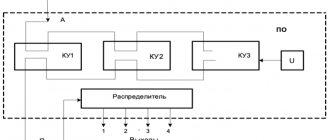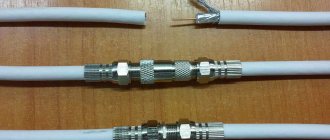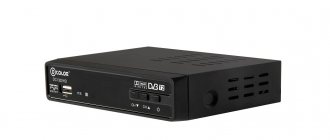In Russia, on February 11, the first stage of the transition to digital broadcasting starts. “RG-Week” tells how this will happen, what to pay attention to and what not to be afraid of.
Throughout the country, 20 federal channels are already broadcast in high digital quality with good stereo sound. In February, the analogue transmitters that broadcast programs from these federal channels will begin to be switched off. Already in the summer, they will broadcast only digitally throughout the country. Regional TV channels will continue to air in analogue format. The question of the transition is still open. The decision will be made closer to 2021. Two options for digital regional broadcasting are being considered. The first is two two-hour inserts on the air of the federal channel “Public Television of Russia” (OTR), the second is the creation in the regions of their own packages of digital TV channels. But the broadcast in both cases will be at the expense of the constituent entities of the Russian Federation. If we talk about the transition to digital broadcasting of federal channels, the government decided to disconnect them from analogue channels in the regions in stages: February 11, April 15 and June 3.
Infographics "RG": Alexander Chistov / Tatyana Shadrina
When will your region switch to digital?
11 February
The transition will take place in seven regions: Magadan, Penza, Ryazan, Tula, Ulyanovsk, Yaroslavl regions, and the Chechen Republic.
April 15
Another 20 regions will be added to them: Amur, Ivanovo, Kemerovo, Kirov, Kostroma, Kurgan, Lipetsk, Moscow, Novgorod, Sakhalin, Tyumen regions, Moscow, Kabardino-Balkarian, Karachay-Cherkess, Udmurt, Chuvash Republics, Kalmykia and Mordovia, Stavropol region, Yamalo-Nenets Autonomous Okrug.
June 3
The final stage. It concerns 58 regions. The transition to digital will occur in the Altai Territory, Arkhangelsk, Astrakhan, Belgorod, Bryansk, Vladimir, Volgograd Regions, Jewish Autonomous Region, Trans-Baikal Territory, Kaliningrad, Kaluga Regions, Kamchatka, Krasnodar, Krasnoyarsk Territories, Kursk, Leningrad, Murmansk Regions, Nenets Autonomous Okrug, Nizhny Novgorod, Novosibirsk, Omsk, Orenburg, Oryol regions, Perm, Primorsky Krai, Pskov region, Adygea, Altai, Bashkortostan, Buryatia, Dagestan, Ingushetia, Karelia, Komi, Mari El, Sakha (Yakutia), North Ossetia - Alania , Tatarstan, Tyva, Khakassia, Rostov, Samara, Saratov, Sverdlovsk, Smolensk, Tambov, Tomsk regions, Khabarovsk Territory, Khanty-Mansi Autonomous Okrug, Chelyabinsk Region, Chukotka Autonomous Okrug.
RTRS employees will tell you which direction to point the antenna. Photo: courtesy of RTRS
Attention:
After analogue transmitters are turned off, those who are not prepared to receive a digital signal will have a static image broadcast on their TV for a whole week with information that the analogue broadcast has been turned off. There will also be phone numbers on the screen where you can get advice about the equipment you need to purchase to receive digital television and how to install it.
Theory
In those early post-war years, when digital signal transmission was known only in secret laboratories, but people already wanted to watch TV, there were three competing analog standards. The first was the American NTSC (National Television System Committee), which had been developed since the 40s, was “tailored” to the American network frequency of 60 Hz and had a vertical resolution of only 486 lines. A little later, the PAL (Phase Alternating Line) standard began to be developed in Germany, which was slightly better than the American one (resolution of “as many as” 576 lines and focus on the European network frequency of 50 Hz), and a little later the French SECAM (Séquentiel couleur à mémoire) appeared. It eliminated some of the shortcomings of PAL, which related to color transmission, and there is a version that the adoption of two standards was also a political decision so that residents of some countries could not watch programs from other countries (the unified European Union and Schengen were still about 50 years away) . One way or another, the whole world was divided something like this:
Because Habr is still a Russian-language site, so in the future we will consider SECAM, although if someone sends a sample of a PAL signal, it would also be interesting.
The SECAM spectrum, according to ancient scrolls, looks like this:
On the left, at frequency F0, is the amplitude-modulated luminance (L) signal. This is actually a black and white image, which can still be shown on the old warm and tube black and white TV. The problem of Legacy and the presence of older devices among users existed already then, so the color channel was added separately, without losing compatibility with older television receivers. Two color channels were transmitted alternately in frequency modulation at frequencies of 4.25 and 4.406 MHz. And finally, even higher in frequency, sound was transmitted separately, also in frequency modulation.
By the way, there is a funny thing about TV reception in St. Petersburg. As Russian media reported, analogue TV was turned off back in October:
However, this only applies to state channels
, commercial ones are not forced by anyone to turn off their broadcasting. At least at the time of writing (December 2019), approximately 5-6 channels are still available in “analogue” right in the center of St. Petersburg. But how long this will last is unknown, so those who want to record signal samples “for history” should probably hurry up.
Finally, it's time to turn on SDR and see what we have in real life:
The audio channel is not difficult; you can simply hover over it with the mouse in HDSDR, select FM with a bandwidth of about 50 KHz and listen. We will start decoding from the luminance channel, this will allow us to get the finished “picture”.
How do you find out that your TV can receive the required broadcast standard?
Many Russians already have flat-screen TVs, but even among them there are some that are not suitable for receiving digital broadcasts. And we need to pay attention to this. The receiver must support the DVB-T2 standard. Information about this is indicated on it.
But in order for such a TV to catch a digital signal of the DVB-T2 standard, you need a decimeter antenna. It can be either home or communal.
Infographics "RG": Alexander Chistov / Tatyana Shadrina
So far there are only a few houses where there are such common antennas, and therefore the regions are recommended to take measures to restore systems for collective reception of terrestrial television in apartment buildings, but in digital format. The bulk of the remaining antennas on the roofs of houses are analog. They need to be gradually changed to decimeter ones.
Procedure for connecting digital broadcasting
Before you learn how to convert your TV from analog to digital, determine whether you need to buy a receiver or whether your model is equipped with one initially.
You can set up a TV receiver from LG, Samsung, Sony, Philips, etc. yourself. To do this, proceed according to the following scheme:
- Install the antenna. You can use a regular room. But at the same time, take into account the remoteness of the television tower and the presence of other natural obstacles that affect the quality of the signal. If the tower is far away, it is better to install an outdoor dish. When installing, point it at the TV tower, so the signal will be of better quality.
- Connect the antenna using the special cable. However, remember that if it is equipped with a built-in tuner, the device is connected directly to the receiver. If the device works with a set-top box, it should be connected to a tuner.
- Find the channels you need. The easiest way is to use automatic search. To enable this function, use the instructions for your TV, as different brands launch automatic search differently. You can find channels manually, then the image will be clearer.
How much does the set-top box cost?
The cost of set-top boxes and televisions for receiving digital broadcasts should not increase due to the fact that analogue federal airwaves have been switched off in your region.
More than 1,700 TV models supporting the DVB-T2 standard are sold in Russia. This is 93 percent of all models available on the market. The minimum price for a TV is 6,790 rubles. Retail sales also include more than 200 models of digital set-top boxes for analog TVs. The price of the set-top box starts from about a thousand rubles.
Volunteers will help you select the necessary equipment for receiving digital television and set it up. Photo: RIA Novosti
The largest Russian retail chains will today sign a memorandum on the sale of set-top boxes for receiving digital television. The minimum cost of the simplest set-top box, which will allow you to receive a digital terrestrial signal on analog TVs according to this document, should not exceed 990 rubles.
The website smotritsifru.rf has a map containing the addresses and contact details of 3,191 stores in all regions of Russia, where you can buy modern TVs that support the digital standard, as well as digital set-top boxes and indoor and outdoor UHF antennas. The map shows both large retail chains and small shops. The service helps those who want to replace their TV, buy an antenna or a DVB-T2 digital set-top box in addition to an old-style TV.
To search for the required store, you need to enter the name of the locality in the “Sales Points” section on the interactive map. The map provides contact information for the store and its name, as well as information about what types of receiving equipment are on sale. Interestingly, according to the Ministry of Telecom and Mass Communications, Russians prefer to buy new TVs right away. In November-December, TV sales in the country doubled.
Infographics "RG": Alexander Chistov / Tatyana Shadrina
How the transition to digital broadcasting is carried out
How to understand what kind of television a subscriber has: digital or not? If, after turning on the TV, an information video appears on the screen about how to switch to digital, it means that the television is analog and you need to make the transition to the new format yourself. The absence of an information video means that the broadcast was initially carried out in DVB-T2 format or cable television was connected.
It is easy to understand that reception from analogue TV has automatically switched to digital, paying attention to some points. To check, you should launch one of the central channels, for example, “First” or “Russia 1”. If there is a large "A" next to the logo, the device is receiving an outdated signal. In some cases, automatic channel search will correct the situation. If the TV supports the DVB-T2 format, then after automatic or manual search the letter “A” should disappear.
Those who watch digital TV through a regular UHF antenna may require additional configuration. Most TVs manufactured after 2013 have a built-in decoder.
The following steps are recommended here:
- Use the remote control to start the TV receiver.
- Next, open the main menu and go to the channel search section.
- Select "Automatic Search" and follow the instructions that appear on the screen.
- When manually searching, important data is the multiplex frequency and channel number. This information can be found on the website rtrs.rf, which provides an interactive map of all regions and television towers.
If your TV receiver does not support the DVB-T2 format, you will have to buy additional equipment. When choosing a set-top box, you should pay attention to its connectors. It is best if the connection is made via an HDMI cable, provided that both the TV receiver and the receiver have this interface. Otherwise, you will need to buy a special adapter.
The principle of setting up an external set-top box for a TV is as follows:
- The antenna plug must be inserted into a special socket on the body of the set-top box.
- Audio and video cables are connected to the appropriate interfaces. The best option is to use an HDMI cable.
- Connect power supply and start both devices.
- In the TV receiver menu, the signal source is selected, depending on the interface used.
- After that, configure and search for channels. It is recommended to select "Automatic search". If it does not bring satisfactory results, you will need to search for channels manually. For this, the multiplex frequency and channel number are used.
Will there be a broadcast via satellite?
There is no on-air digital coverage in more than 1,800 settlements in Russia. The list of settlements whose residents should be provided with free viewing of 20 publicly accessible channels by television operators has already been approved by the Ministry of Communications.
Regional authorities, as far as the budget allows, provide financial assistance for its purchase and installation to those who cannot afford equipment for receiving a television signal via satellite. Here you have to pay for the installation of equipment.
Russians can watch 20 publicly accessible federal TV channels in high quality and with good stereo sound.
RTRS employees will tell you which direction to point the antenna to receive a TV signal.
Where there is no terrestrial signal, satellite operators are required to provide free reception of 20 channels. Photo: Natalya Savankova
Specifically










